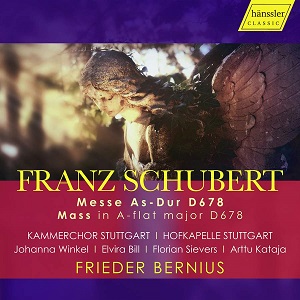
Franz Schubert (1797-1828)
Mass in A-flat major D678 (1819-22, rev. 1825)
Johanna Winkel (soprano); Elvira Bill (alto); Florian Sievers (tenor); Arttu Kataja (bass)
Kammerchor Stuttgart
Hofkapelle Stuttgart/Frieder Bernius
rec. 2021, Hegelsaal, Liederhalle, Stuttgart, Germany
Latin text with German translation included
Hänssler Classic HC22041 [43]
The A-flat major Mass is one of two great, late masses by Franz Schubert, the other being in E-flat that he composed shortly before his death. These are both big works, each of which Schubert designated as a “missa solemnis,” and which have received a number of fine recordings. I can happily add this new account by the redoubtable Frieder Bernius and his Stuttgart forces to a list of outstanding performances of the A flat Mass. Bernius has excelled in nearly every choral work he has recorded and this one is no exception.
Bernius, as is his usual practice, employs a chamber orchestra and chorus, which is the norm these days, unlike some earlier accounts. Wolfgang Sawallisch recorded the mass twice, both with larger forces and with broader tempos than Bernius, who takes less than 44 minutes, but does not at all seem hasty. Another account with which I compared this one is by the Immortal Bach Ensemble and Leipziger Kammerorchester under Morten Schuldt-Jensen (Naxos), who get the job done in 40 minutes and which received a favourable review here (review). These are all viable alternatives, depending on one’s preference concerning approach. I am comparing Bernius here with Schuldt-Jensen, both of which really appeal to me.
These performances, not only use smaller forces, but also follow period practice with what I assume are modern instruments and the choir’s straight tone. I do not have a preference for one vocal quartet over the other. They are both excellent, not overdoing the vibrato and maintaining a certain lightness that suits the two interpretations. The vocal soloists blend well with the choir and orchestra and are not unduly spotlighted, as is sometimes the case. However, I found that Bernius brings out more of the wonderful, instrumental detail than Schuldt-Jensen. Some of this is likely due to the clearer sound on the new recording, where one can appreciate Schubert’s writing for the woodwinds to a greater degree. The incisiveness of Bernius’s timpani also is telling, as is the brief brass fanfare in the “Cum Sancto Spiritu” section of the Gloria. This is due to the conductor’s choices rather than the sound of the recording per se, I would think. The trombone entries in the Credo, on the other hand, are somewhat more imposing with Schuldt-Jensen. Both forces utilize the German pronunciation of the Latin, which is what one would expect and what Schubert probably knew, too. The diction of each choir is clear, as is that of the soloists, and their intonation is spot on. One advantage of the Naxos CD is that it contains another work, the short Magnificat in C major Schubert composed in 1816, whereas the Hänssler disc contains only the mass. The CD could easily have accommodated Schubert’s popular Mass in G major of 1815 and would have given greater value for the outlay.
As it is, one can enjoy this new account of one of Schubert’s most memorable, songful masterpieces in a superb rendition and not feel short-changed. Hänssler provides a more than adequate discussion of the work in the accompanying booklet and bios of the vocal soloists in German with English translation, as well as the text and a listing of both choir and orchestra members.
Leslie Wright
Help us financially by purchasing from




















